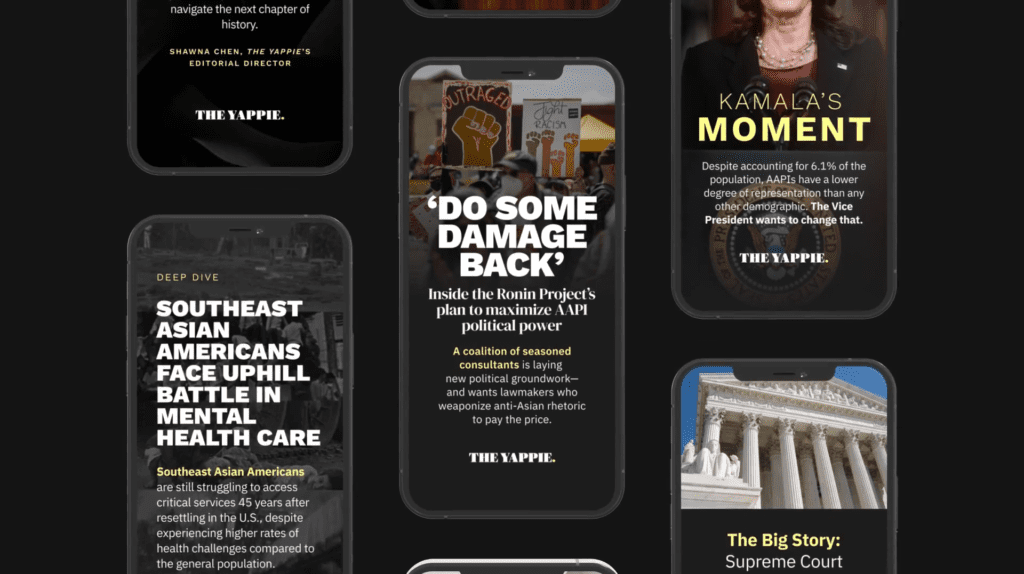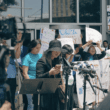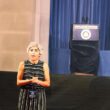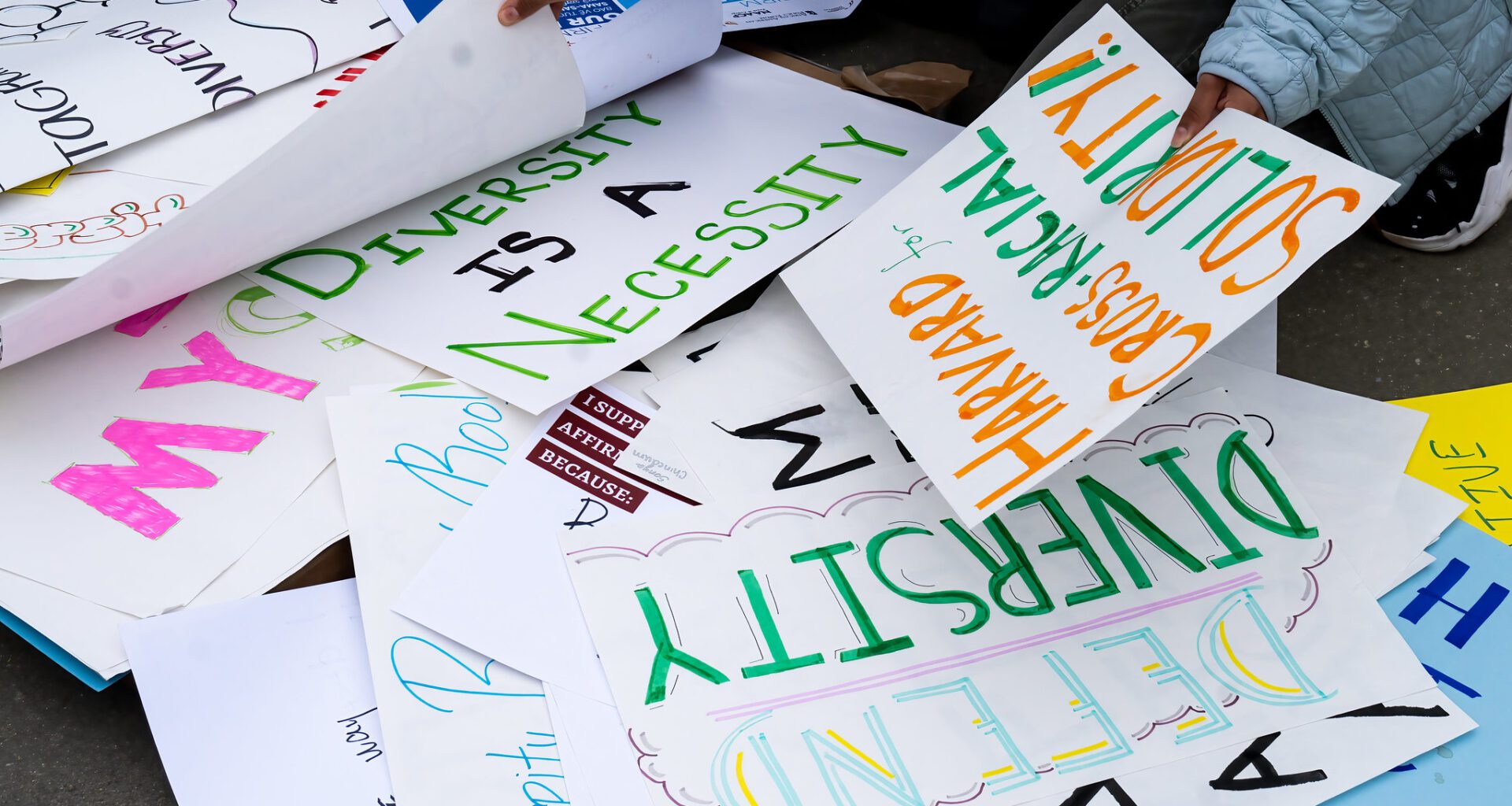EDITOR'S NOTE
This story was first published via the Asian American Journalists Association’s Voices program.
Harvard sophomore Kawsar Yasin started her day on June 29 by refreshing the U.S. Supreme Court’s website for new opinions from her home in Tyler, Texas. In Washington, D.C., University of North Carolina junior Sarah Zhang was doing the same.
At 10 a.m. Eastern time, there it was: The court had overturned affirmative action in college admissions in cases involving Yasin and Zhang’s schools. The decision overruled decades of precedent, casting into doubt the future of race-based admissions.
Though Yasin thought she was ready for an unfavorable ruling, she said she still felt shock as she read it. “I just don’t think I was prepared to see that, when I finally refreshed the page and I actually got to the actual decision,” Yasin said.
Separated by more than 1,000 miles, Yasin and Zhang quickly launched into plans for what they considered the worst-case scenario. Yasin, education and political co-chair for the Harvard-Radcliffe Asian American Association, shared the group’s statement condemning the ruling on her social media accounts. By noon, she had mobilized friends to attend protests on Harvard’s campus and in Washington. Zhang spent her morning doing TV news interviews, while other members of her student group, the Affirmative Action Coalition at UNC, circulated its own prepared statement.
At Harvard and UNC, whose admissions policies were judged before the court, students had for months built grassroots coalitions, hosted rallies, spoken out, and educated their peers in hopes that the court would rule for affirmative action and the student diversity they say has been fundamental to their college experiences.
But once the initial post-decision frenzy died down, activists immediately began looking toward the future of diversity, equity, and inclusion on their campuses.
“By 3 or 4 p.m., I think that’s when a lot of us actually started processing what was happening—and thinking about what we wanted to do as next steps,” Zhang said.
Cultivating a community
Affirmative action opponents have challenged use of the practice by colleges and elsewhere in the U.S. for decades, but conservative activist and Students for Fair Admissions founder Edward Blum, after first targeting other universities, launched his organization’s lawsuits against Harvard and UNC in 2014. The claim was that their admissions practices discriminated against Asian Americans and violated the Fourteenth Amendment, respectively.
When local nonprofit North Carolina Asian Americans Together reached out to UNC students to speak on the issue, Zhang first envisioned a pro-affirmative action student group on campus. They had been involved in Asian American activism and local politics before but realized she wanted to focus on affirmative action. She posted on social media, seeking other students who felt the same.
“All of our parents were immigrants,” Zhang said. “All of us were either first-generation college students or our parents had been first-generation college students. All of us grew up in predominantly white communities. And all of us found diversity to be super important.”
The four-person coalition they formed sought to spread awareness and encourage other UNC students to think critically about the decision and the value of diversity on campus.
“People who benefit from affirmative action, we belong at institutions like (UNC),” Huang said. “Future generations who are going to be our next leaders, they need systems to make sure that they have an equal playing field.”
Weeks of teach-ins, open mics, and poster-making sessions culminated with two rallies attended by hundreds of students: one on Harvard’s campus days ahead of the Oct. 31 arguments and the other the day of, in front of the Supreme Court in Washington.
“So many Harvard students decided, ‘I’m not going to go out and party on my Halloween weekend. I’m going to go show up in front of the Supreme Court,’” said Emma Lu, a Harvard sophomore and member of the Harvard Affirmative Action Coalition. “It shows that we take it seriously. It shows that we know the impact that diversity in higher education makes, and so should the people who see us show up.”
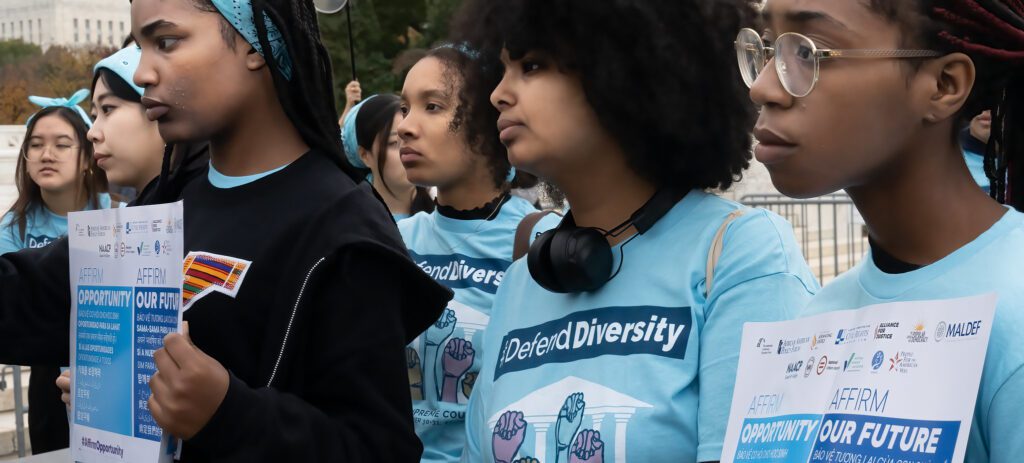

Turning sympathy into solidarity proved difficult
Activists at Harvard and UNC found that, outside their core coalitions, many of their fellow students supported affirmative action, or at least didn’t actively oppose it. Translating their peers’ sympathy into solidarity and action, however, proved a more difficult task.
“It was really, really hard to find people who cared about affirmative action,” Zhang said. “I don’t blame people for not caring. I think there are a lot of issues that are more immediate.”
UNC’s administration has seen a spate of race-based activism in recent years. When Nikole Hannah-Jones, journalist and author of The 1619 Project, was denied tenure by the administration in 2021, several hundred students demonstrated outside the chancellor’s office. In 2018, student protesters toppled Silent Sam, a statue of a Confederate soldier located on campus. Zhang said that despite all of this, it was difficult for affirmative action to gain traction as a cause.
Huang and Zhang theorized that among all the political turmoil at UNC in the last year, affirmative action couldn’t break through. “Growing up in a generation with so much noise, we’re always seeing these pressing issues weigh on us,” Zhang said. “I think our generation cares a lot more about social welfare and gun safety and climate change and things that might feel more urgent.”
Lu acknowledged that some students don’t get involved in the affirmative action activists’ efforts because of their satisfaction with the “status quo.” At Harvard, she said, it’s easy to focus only on resume building and one’s own self-interest. For many who did join the movement, it was their first experience with activism.
But Lu highlighted the solidarity between the various groups in the coalition in support of affirmative action as “really something special,” even as she noted the difficulty of gauging its overall effect.
“A lot of the times when young people are involved with activism, it feels like, ‘I actually don’t know what sort of impact I’m making. Is there actual change being done, or is the system too powerful in that sense?’” Lu said. “But I think that it’s just so important to show out and voice that we are here.”
Harvard sophomore Kashish Bastola recounted the “nerve-racking” experience of visiting dining hall tables to advertise a Legal Defense Fund teach-in. A “huge portion” of students, he said, was unreceptive and criticized affirmative action.
But some of them changed their minds after learning facts such as Harvard’s Asian population has grown from 3% of the class of 1980 to about 30% of the class of 2027.
“The same people who seemed to really be challenging what I had to say and what I was advocating for came to the teach-in,” Bastola said.
Mitchell Chang, associate vice chancellor of equity, diversity, and inclusion at UCLA, said that advocacy for affirmative action “is not a simple message” to convey. “It requires a pretty large dose of historical background to understand why such a policy is necessary,” he said. “It’s very easy for students to judge it on the surface level.”
Chang referred to the mixed results of a 2023 Pew Research Center national survey on Asian American attitudes toward affirmative action that found that while about 50% of Asian American adults who had heard of affirmative action supported it, only about 21% of Asian American adults believed race or ethnicity should be factored into admissions decisions. “It’s become more of a message where people are hearing winners and losers. Their perception is, ‘I’m going to lose.’”
Zhang mentioned facing a similar disconnect in their campaign to spread awareness: “There have been people who have come up to us while we’re tabling and have no idea what affirmative action is. And when they first hear it, they say, ‘That’s unfair. I care about diversity, but this sounds like an awful thing.’”
Working to dismantle stereotypes
While researching her book on diversity in higher education called “The Diversity Bargain,” Natasha Warikoo noticed how anti-affirmative action advocates tried to recruit Asian Americans.
“I am Asian American, and I kept getting these ads saying, ‘Were you rejected from Harvard? Were you rejected from Yale?’” she said. “You’d see a picture of a forlorn-looking young adult who looks Asian American in the ad.”
Warikoo, a sociology professor at Tufts University, said that “the logic is that Asian Americans can bolster the case because we are a racial minority.”
“I kept getting these ads saying, ‘Were you rejected from Harvard? Were you rejected from Yale?’”
—Natasha Warikoo
Many of the activists who identify as Asian American felt a responsibility to denounce the narrative that Asian Americans oppose race-conscious college admissions and express solidarity with other racial minorities. Huang said she was inspired to join the coalition partially to “dismantle a lot of the stereotypes” about Asians and affirmative action.
“Hearing the anti-Black rhetoric and a lot of the racism that’s coming out of it … I felt like there was a lot to do in that sphere,” she said.
Zhang also said the coalition was asked by reporters to comment on the case from an Asian American perspective. “We just talked about how we felt like we were being driven between communities as a wedge,” Zhang said.
Huang said she believes that she, a Chinese American, first-generation student, benefited from affirmative action. She said she didn’t “match up” with the scores and grades of an out-of-state applicant, but that UNC saw her holistic experiences and viewed her as qualified.
“I say this a lot, but if affirmative action really truly hurt Asian Americans, I would not advocate for affirmative action,” Huang said.
‘A lot left to be done’
College applicants and current students alike are now figuring out how to navigate a world without affirmative action. The coalition members, though, insist there’s still plenty to fight for and hope to maintain the energy of the past few months.
When affirmative action was banned in California in 1996, students from underrepresented groups quickly saw the repercussions. Chang of UCLA said he believes that the Supreme Court decision will have similar effects nationwide.
“In all likelihood, those underrepresented populations in the short term will get smaller,” said Chang. “Research shows that when the numbers get smaller, those students are at greater risk of experiencing microaggressions, isolation, and stereotyping, and they’re less likely to see same-race peers in their classes.” The heightened level of microaggressions experienced by underrepresented student populations has been documented in numerous publications, including in the journals American Behavioral Scientist and Science.


In a statement, Blum said SFFA will next focus on how colleges and universities comply with the Supreme Court’s decision. Inside Higher Ed reported that SFFA sent a letter of demands, including to stop providing admissions officers “check box” data about applicants’ races, to 150 colleges on July 11.
Now, activist groups on campus have to push for renewed investment in diversity and inclusion in a world without affirmative action. “They will have to signal to these populations that they not only welcome them, but they value them,” Chang said.
Accordingly, student activists are refocusing their energies on how they can work with their universities to promote inclusivity on campus in other ways. Bastola listed priorities such as an ethnic studies concentration, on-campus cultural centers, and increased outreach to high schools in underserved and underrepresented communities.
“I’m the first student from my high school to go to Harvard, and I’m passionate about building pipelines with schools that have never sent a student to Harvard before. There’s just so much room for us to keep moving forward,” Bastola said. “I’m confident that the advocacy, the continued push for equity will not go away. There’s a lot left to be done, and I’m excited.”
Shruthi Kumar, a senior at Harvard and student lead for the Affirmative Action Coalition, said the decision represents an opportunity for the college to “reimagine” its admissions policies.
Kumar said the process should be more holistic and allow students to better showcase their background and circumstances, such as family immigration history, in their application.
“Can you really get to know who the student is, where they come from, what their environment is, what their family life is, how that has led to the things that they’ve done?” Kumar said. “That’s what it really means to get to know a person.”
When asked if the Affirmative Action Coalition at UNC would change its name following the decision, the members said no. “Affirmative action ties into preserving and defending diversity. It is always going to be under threat,” Zhang said. They explained that the coalition still wants to support affirmative action in corporations, businesses, and other places, even if it has been overturned at the higher education level.
Huang wants the Affirmative Action Coalition to have a legacy beyond its current work, especially as recent media coverage has brought attention to the efforts of student activists. She plans to help archive the coalition’s work, get both alumni and new students involved, and establish permanent connections with the administration. She hopes she can create foundations that other activists can build upon.
Since the decision was released, UNC and Harvard have both declared that they are working on next steps to restructure their admissions while still preserving diversity. On July 7, UNC Chancellor Kevin M. Guskiewicz announced UNC will provide free tuition and required fees for incoming undergraduates from North Carolina whose families make less than $80,000 per year. “Our University’s commitment to access and affordability and supporting a culture of belonging for everyone does not change with last week’s ruling,” said the statement.
“I think the decision is just the beginning,” Kumar said, “for a larger-scale reckoning of what the education system in the U.S. looks like.”




